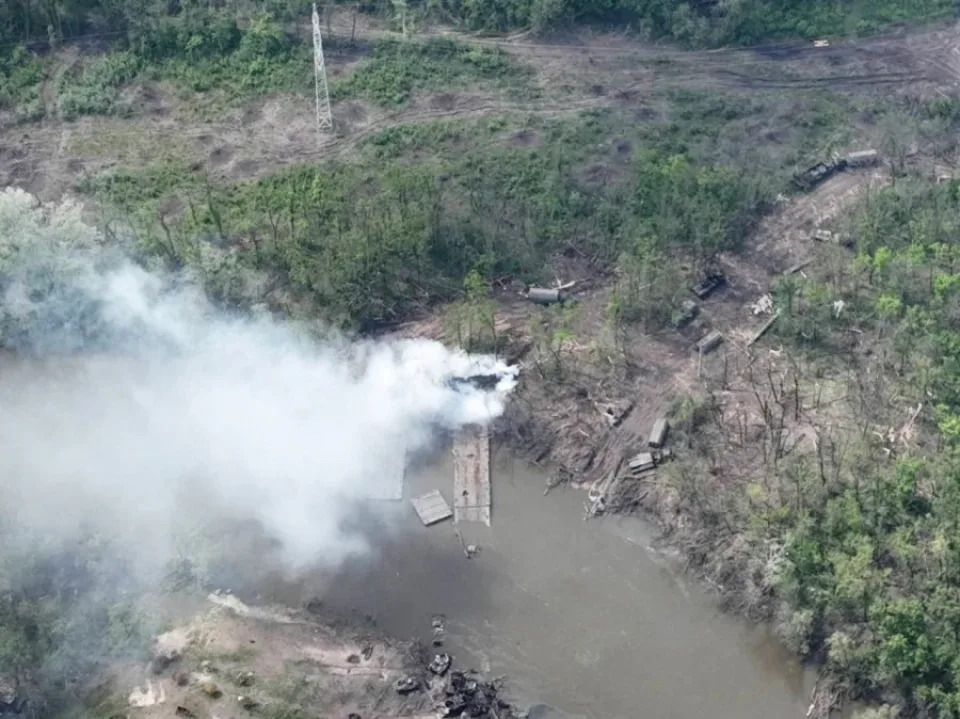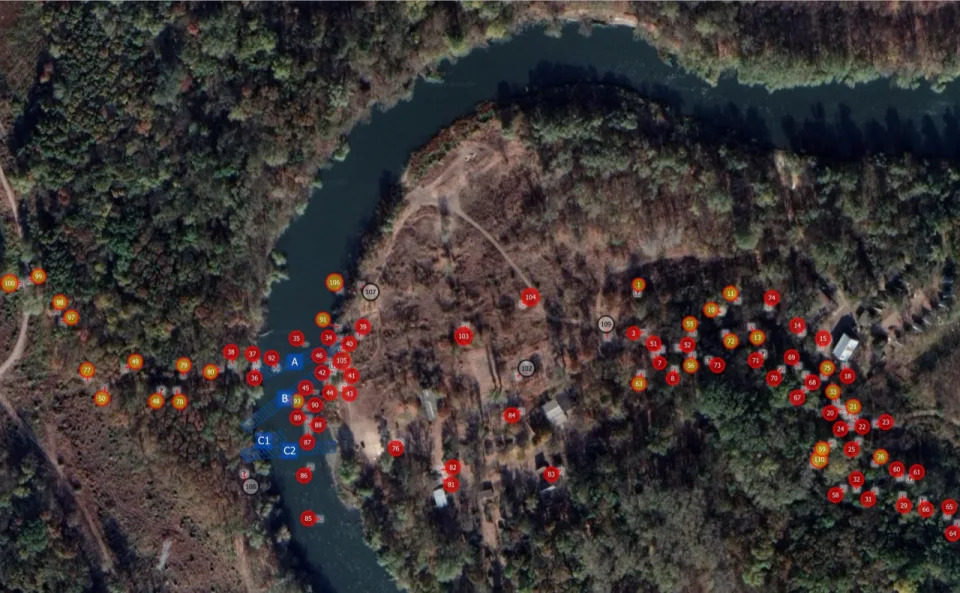The New Voice of Ukraine
Ukraine’s stymies Russian efforts to cut off Luhansk in Bilohorivka
May 21, 2022

Despite the fact that heavy fighting is still going on in the region, thanks to the extraordinary professionalism of the Armed Forces, this episode has already gone down in the history of war with Russia.
The New Voice of Ukraine sums up what there is to know about the defeat of the Russians near Bilohorivka.

A strike on a school in Bilohorivka and construction of a pontoon crossing: what the invaders were trying to achieve
Before the Russian invasion, about 1,000 people lived in the village of Bilohorivka (Sievierodonetsk district, Luhansk Oblast). However, in early May 2022, this small town gained exceptional strategic importance on military maps.
It was in this area that Russian troops tried to ford the Siverskyi Donets River, a natural barrier between the Armed Forces and the invaders in the hottest parts of the front.
A successful breakthrough and the development of the Russian army’s offensive near Bilohorivka could allow it to take control of the Lysychansk-Bakhmut route, which Luhansk Regional State Administration Chairman Serhiy Hayday calls the “road of life” — it connects the region with Ukrainian-controlled territories. In addition, such a breakthrough could increase the threat of the encirclement of some Ukrainian forces defending the settlements of Sievierodonetsk and Lysychansk.
On May 7, the Russian army resorted to “preparatory” actions, launching an airstrike on a school in Bilohorivka, where almost 90 civilians were hiding. About 60 of them are believed to have been killed in the attack.
Read also: Putin the loser
On the evening of May 8, Serhiy Haidai announced for the first time that the Russians had managed to erect a pontoon crossing over the Siverskyi Donets and even transported a certain amount of equipment to the other bank, which turned Bilohorivka into a hotbed of fighting.
“If [the invaders] entrench themselves, they can develop an offensive and get closer to the road, cutting off Luhansk Oblast — it will mean the loss of the single path to safety and communication with other regions,” Hayday stated in his morning report on May 9, when Moscow pompously celebrated Victory Day.
“Today is decisive. Let’s fight for the “road of life” […] Trust in the Ukrainian Armed Forces! We have everything to defeat the ogres. As they crossed the river, so will they swim back.”

The Ukrainian army managed to realize such hopes almost literally: in the following days, Ukrainian defenders destroyed several such crossings, forcing the Russians to flee, even by swimming. At the same time, a huge amount of enemy equipment and personnel was destroyed, comparable to the staffing of one or two battalion tactical groups (BTG) of the Russian Federation.
Bilohorivka as a new Chornobaivka: what losses and how exactly the Armed Forces inflicted them on the Russians
According to journalist Yuriy Butusov, the most active phase of fighting in the Bilohorivka area took place on May 5-13, when units of the 58th Motorized Infantry, 80th Air Assault, 128th Mountain Assault, and 57th Motorized Brigades of the Armed Forces repulsed Russian troops.
With strong artillery support, the Ukrainian military managed not only to destroy the original crossing and enemy forces that were trying to form the first bridgehead but also to crush several other attempts by Russia to build pontoon bridges.
According to the New York Times, Russian commanders sent about 550 servicemen of the 74th Motor Rifle Brigade of the 41st Army to ford the Siverskyi Donets near Bilohorivka.
At least 485 of them were liquidated by Ukrainian defenders, along with more than 80 units of Russian equipment, according to the Institute for the Study of War. These are the most conservative estimates: according to Butusov, Russia has lost even more near Bilohorivka — over 100 units of military equipment.
Similar assessments were made by analyst Pavel Voylov, who meticulously summarized all available photos and videos from Bilohorivka and published an extremely detailed database of the defeat of the invaders in their attempt to ford the Siverskyi Donets.
Read also: Details about the sinking of Russia’s Moskva flagship emerge
This database contains 110 objects (equipment and engineering constructions) in Bilohorivka and its vicinity. Among them are tanks, infantry fighting vehicles, armored personnel carriers, tugboats needed to construct the crossing, and other Russian military equipment, such as:
- 58 destroyed and sunken objects: they are marked in red on the map below (10 tanks, 31 infantry fighting vehicles, 3 airborne combat vehicles, 3 floating armored personnel carriers, 1 armored repair and evacuation vehicle, 1 landing armored personnel carrier, 2 tugboats, 1 pontoon park vehicle and 6 unknown objects);
- 31 possibly destroyed or damaged objects marked in khaki (2 tanks, 9 infantry fighting vehicles, 4 floating armored personnel carriers, 1 floating conveyor, 9 pontoon park vehicles, 3 pontoons on the shore and 3 unknown objects);
- 4 objects without any damage, displayed in white (2 tanks, 1 infantry fighting vehicle, and 1 unknown object).
“The total number of destroyed, sunk, possibly destroyed or damaged objects today [May 18] is 89 units,” Voylov says.
Of this number, some of the objects may be only damaged, but, on the other hand, there are very few photos and videos of Bilohorivka-North – only one reliably destroyed object has been identified there so far. Given that the enemy was forced to retreat to the crossing as a result of the battle, its losses there are probably uncounted.
According to sources cited by the Ukrainian military news outlet Defence Express, after the devastating defeat near Bilohorivka, remnants of the Russian 74th Motor Rifle Brigade withdrew from Ukrainian territory to the Voronezh region of the Russian Federation, due to a complete loss of combat capability.
This data suggests all three motorized infantry battalions of this brigade were defeated, and in the tank battalion of 31 vehicles, there were only five tanks capable of moving by themselves.
It is worth noting that this brigade, from the beginning of the invasion, operated near Chernihiv and Nizhyn, where it had already suffered losses, and after the Russians retreated from northern Ukraine, it was transferred to the Izyum axis.
Butusov, who visited the battlefield near Bilohorivka shortly after a successful counterattack by the Ukrainian Armed Forces, said that at first the enemy managed to transport several dozen units of equipment to the Ukrainian-controlled bank of the river.
The invaders tried to gain a foothold in 1 square kilometer area, “and this could be — and was — a really big problem for us,” Butusov said.
“But our troops in very difficult conditions, where the situation was constantly changing, went into battle, and the attacks of our infantry stopped the advance of the enemy on the bridgehead,” Butusov said in a video dated May 15, after returning from Bilohorivka.
“And after the infantry restrained a further offensive, our artillery precisely targeted Russian equipment, Russian reserves, Russian infantry — now everything has been driven out of our bank of the Siverskyi Donets.”

The YouTube channel Ukrayinskyi Svidok (‘Ukrainian Witness’), which documents the war with Russia, also released a video of a “cemetery” of Russian equipment from the area where the enemy army tried to ford the Siverskyi Donets.
These shots were taken by one of the Ukrainian service members who took part in the hostilities.
Around the same time, Russians tried to cross a river in the Dronivka area, 12 km west of Bilohorivka, but failed there as well.
The 30th Prince Konstantyn Ostrogski Mechanized Brigade reported that Russian troops were trying to create three bridgeheads near the village of Dronivka.
“But the heroism and resilience of our infantry, artillery, and tankers of the 30th Mechanized Brigade and other units of the Armed Forces managed to stop the Russian troops and inflict heavy losses on them,” the Ukrainian military noted, releasing video footage of the act.
The clip shows the destruction of about 15 units of enemy military equipment, including three infantry fighting vehicles, two tanks, pontoons, boats, and amphibious, and engineering vehicles, according to Defence Express.
Consequences and assessments of the enemy’s defeat near Bilohorivka
As of May 20, heavy fighting continues in Luhansk Oblast. The invaders are destroying local towns and villages, and Russian forces still control one of the banks of the Siverskyi Donets. However, new attempts to ford the river near Bilohorivka have not been observed yet.
“The orcs are not fording the Siverskyi Donets yet,” said Hayday on May 17.
“(They are) scared. Foreign media reports that (Putin) is personally devising a plan for how this can be done. The Armed Forces of Ukraine are doing everything possible to prevent the Russians from crossing the river, creating a bridgehead for the offensive and cutting us off from the road of life.”
Meanwhile, the global media has noted the proficiency of the Armed Forces in preventing a Russian crossing.
The NYT says that if the reports on the nearly 500 invaders killed while fording the river are confirmed, it will be one of the biggest combat losses of the war with Russia.
The NYT points out that about 500 people were on the sunken Russian cruiser Moskva, but their fate in Russia has been kept under wraps, and the exact number of dead is still unknown.
Read also: Russian catastrophe at Bilohorivka river crossing makes invaders contemplate defeat – NYT
Meanwhile, the Institute for the Study of War in its reports noted that as a result of the defeat near Bilohorivka, the Russian army “likely lost the momentum necessary to execute a large-scale crossing of the Siverskyi Donets River.”
“The attempted river crossing showed a stunning lack of tactical sense as satellite images show (destroyed) Russian vehicles tightly bunched up at both ends of the (destroyed) bridge, clearly allowing Ukrainian artillerymen to kill hundreds and destroy scores of vehicles with concentrated strikes,” the Institute pointed out.
It also said that the defeat near Bilohorivka has provoked a barrage of criticism of the Russian military command, even among pro-Kremlin military bloggers.
Among them is Yuri Podolyaka, a Russian blogger with 2.1 million subscribers on his Telegram channel, who said in a recent video: “I kept silence for a long time. The last straw that overwhelmed my patience was the events around Bilohorivka, where due to stupidity — I stress, because of the stupidity of the Russian command — at least one battalion tactical group was burned, possibly two.”
According to analysts at the Institute for the Study of War, against the background of Russian informational secrecy and propaganda efforts that obscure the real picture of developments in Ukraine, these bloggers’ comments “may fuel burgeoning doubts in Russia about Russia’s prospects in this war and the competence of Russia’s military leaders.”
